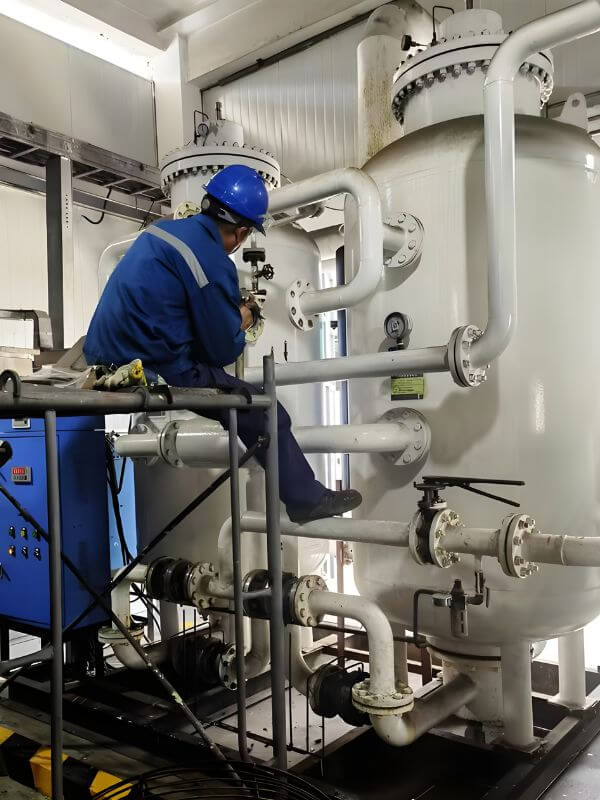Installing a nitrogen generator requires careful attention to details to ensure proper operation. This guide covers key installation conditions and requirements when setting up nitrogen generation equipment like pressure swing adsorption (PSA) units.
Whether handling installation yourself or partnering with technicians, understanding optimal PSA generator setup procedures is essential.
Overview of PSA Nitrogen Generator Setup
PSA nitrogen generators work by separating nitrogen gas from compressed air via selective adsorption under pressure. This nitrogen production process requires proper feeds, connections and ambient conditions to function as intended.
Getting installation conditions right allows your nitrogen gas generator to reliably deliver purity, capacity and efficiency targets. We will explore all key facets of planning and deploying PSA systems:
- Location & Foundation
- Connections & Utilities
- Feed Air Quality
- Environment Standards
- Commissioning & Testing

Adhering to equipment guidelines and using qualified installation services gives you the best chance for success when bringing a nitrogen generation system online.
Placement Guidelines
Determining where to install your PSA unit is an important first step:
- Select based on proximity to point(s) of use to minimize compressed nitrogen gas piping runs.
- Allow sufficient clearances for ventilation and equipment access/maintenance per manufacturer specifications.
- Outdoor installations require protective enclosures and air conditioning equipment.
- Indoor sites should have ample clearance from walls/other equipment – generally >1m spacing between components.
- Building codes may dictate specific foundation requirements based on location seismic zone, unit capacity/weight and other factors.
Proper equipment placement also affects ancillary components like air compressors and nitrogen buffer tanks in the overall system layout. Careful site planning enables optimal functionality.
Critical Feed Air Quality Standards
The quality of compressed air entering a PSA generator heavily impacts performance. Air filtration is crucial to remove moisture, particulates and oils that can degrade separation membranes and output purity.
Installing air dryers, 0.01 micron coalescing pre-filters and activated carbon towers ensures feed air meets requirements:
- Oil Content: <0.01 ppm
- Particulates: <0.1 micron diameter
- Relative Humidity: 1-3% at system operating pressure
Dew point sensors connected to PLCs help monitor air dryness in real-time as conditions fluctuate. This protects the generator, while heated purge lines prevent liquid accumulation.
Poor air treatment risks 50% decrease in on-stream generator productivity.
Meeting feed specifications, along with using air compressors sized for flow/pressure demands enables stable nitrogen supply with minimal disruptions.
Ambient Standards
PSA generators require specific ambient temperature, humidity and power conditions for optimal separation efficiency.
Key ambient parameters include:
- Temperature: 0 – 40°C
- Humidity: ≤85% RH
Precise instrumentation like independent thermometers, hygrometers and power quality meters help qualify installations.
The Importance of Proper Commissioning
Upon completing all physical PSA nitrogen system installation steps, commissioning activities ensure components work in harmony.
Certified technicians methodically tune and validate performance across operating ranges by:
- Confirming leak-free pipe and tube connections via soap tests and thermal imaging
- Adjusting nitrogen purity settings
- Tuning control loop parameters
- Optimizing cycle times
- Verifying output flow capacity, pressure dew point, etc. meets specifications
Proper commissioning procedures also incorporate:
- Safety review
- Operator training on start-up sequences
- Establishing maintenance schedules
- System monitoring & alarm provisions
This comprehensive process enables confident hand-off to production teams. Partnering with an expert service provider streamlines bringing installations online while building operational knowledge.
Conclusion
Getting the most from your nitrogen generator requires concerted planning and execution across all facets of installation. Paying attention to feed air quality, site provisions, ambient conditions and commissioning gives your operation a solid foundation for productivity and reliability.
Collaborating with qualified technicians who understand the nuances of PSA nitrogen system deployments provides further assurance your project goals are met from the start.

